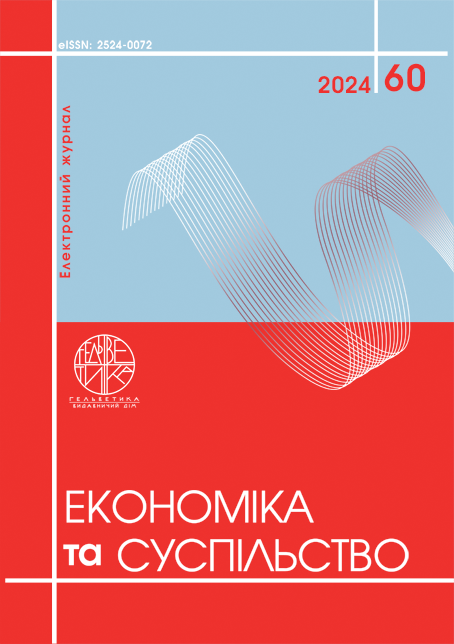TRENDS IN ENTERPRISE RISK MANAGEMENT RESEARCH: A BIBLIOMETRIC ANALYSIS
Abstract
The need for effective Enterprise Risk Management (ERM) has never been greater than today, as organizations face complex and interconnected risks. Macroeconomic and geopolitical uncertainties, digital transformation across industries and sectors, cybersecurity, and climate change, among other trends, present significant uncertainties. This article aims to analyze scholarly works dedicated to ERM research. In many organizations, risk management is underdeveloped; the current standard is a reactive approach to risk management. Typically, it is considered in isolation rather than as a core competency and strategic asset. Consequently, risk management processes are inefficient and perceived as additional overhead for decision-making and responding to uncertainties. In this study, bibliometric analysis was used to gather data on researchers (journals, research organizations, and keywords) to identify the most comprehensive and influential research works defining trends and perspectives in the field of ERM. We utilized the VOSviewer v.1.6.10 software tool with a search query for keywords: "enterprise risk management." Publications from the Web of Science Core Collection (WoS CC) starting from 2014 were analyzed. The research demonstrates a close connection between ERM and corporate governance topics. Additionally, clustering of ERM research directions allowed for the identification of sustainable risk management as a separate and promising research direction within the overall risk management system. Spatial-temporal analysis of enterprise risk management indicates that international ERM research is steadily progressing and has made significant strides in recent years. This trend suggests that more scholars are interested in enterprise risk management. Within this work, research was limited to bibliographic analysis of publications from the Web of Science Core Collection, hence the direction for further research involves expanding data for bibliometric citation and content analysis in other databases such as Scopus or Google Scholar.
References
Arena, M., Arnaboldi M., Azzone G. (2010). The organizational dynamics of Enterprise Risk Management. Accounting, Organizations and Society. 35(7). pp. 659–675. DOI: https://doi.org/10.1016/j.aos.2010.07.003
Bernardi R. A., Pincus K. V. (1996). The relationship between materiality thresholds and judgments of fraud risk. Managerial Finance. 22(9). pp.1–15. DOI: https://doi.org/10.1108/eb018578
Brodeur A., Buehler K., Patsalos-Fox M., Pergler, M. (2010). A board perspective on enterprise risk management. McKinsey &Company.(18). pp. 1–15.
Hopkin P. (2018). Fundamentals of risk management: understanding, evaluating and implementing effective risk management. Kogan Page Publishers. 489 p.
Grishnova, O., Cherkasov, A. & Brintseva, O. (2019) Transition to a new economy:transformation trends in the field of income and salary functions. Problems and Perspectives in Management, 17 (2), pp. 18–31
Kharazishvili, Y., Grishnova, O., & Kamińska, B. (2019). Standards of living in Ukraine, Georgia, and Poland: identification and strategic planning. Virtual Economics, 2(2), 7–36.
Kharazishvili, Y., Lyashenko, V., Grishnova, O., Hutsaliuk, O., Petrova, I., & Kalinin, O. (2023, November). Modeling of priority institutional measures to overcome threats to sustainable development of the region. In IOP Conference Series: Earth and Environmental Science (Vol. 1269, No. 1, p. 012023). IOP Publishing.
Schmitz J., Wittenberg А. (2012) Dynamic Financial Planning – Making Enterprise Risk Management Matter. Risk Journal 2012, 2. pp. 20-27. DOI: https://doi.org/10.13140/RG.2.1.1486.4086
Settembre-Blundo D., González-Sánchez R., Medina-Salgado S., García-Muiña, F. E. (2021). Flexibility and resilience in corporate decision making: a new sustainability-based risk management system in uncertain times. Global Journal of Flexible Systems Management. 22 (Suppl. 2). pp.107–132. DOI: https://doi.org/10.1007/s40171-021-00277-7
Yang S., Ishtiaq M., Anwar M. (2018). Enterprise Risk Management Practices and Firm Performance, the Mediating Role of Competitive Advantage and the Moderating Role of Financial Literacy. Journal of Risk and Financial Management.11(3):35. DOI: https://doi.org/10.3390/jrfm11030035
Arena, M., Arnaboldi M., Azzone G. (2010). The organizational dynamics of Enterprise Risk Management. Accounting, Organizations and Society. 35(7). P. 659–675. DOI: https://doi.org/10.1016/j.aos.2010.07.003
Bernardi R. A., Pincus K. V. (1996). The relationship between materiality thresholds and judgments of fraud risk. Managerial Finance. 22(9). pp.1–15. DOI: https://doi.org/10.1108/eb018578
Brodeur A., Buehler K., Patsalos-Fox M., Pergler, M. (2010). A board perspective on enterprise risk management. McKinsey &Company.(18). pp. 1–15.
Hopkin P. (2018). Fundamentals of risk management: understanding, evaluating and implementing effective risk management. Kogan Page Publishers. 489 P.
Grishnova, O., Cherkasov, A. & Brintseva, O. (2019) Transition to a new economy:transformation trends in the field of income and salary functions. Problems and Perspectives in Management, 17 (2), pp. 18–31
Kharazishvili, Y., Grishnova, O., & Kamińska, B. (2019). Standards of living in Ukraine, Georgia, and Poland: identification and strategic planning. Virtual Economics, 2(2), 7–36.
Kharazishvili, Y., Lyashenko, V., Grishnova, O., Hutsaliuk, O., Petrova, I., & Kalinin, O. (2023, November). Modeling of priority institutional measures to overcome threats to sustainable development of the region. In IOP Conference Series: Earth and Environmental Science (Vol. 1269, No. 1, p. 012023). IOP Publishing.
Schmitz J., Wittenberg А. (2012) Dynamic Financial Planning – Making Enterprise Risk Management Matter. Risk Journal 2012, 2. pp. 20–27. DOI: https://doi.org/10.13140/RG.2.1.1486.4086
Settembre-Blundo D., González-Sánchez R., Medina-Salgado S., García-Muiña, F. E. (2021). Flexibility and resilience in corporate decision making: a new sustainability-based risk management system in uncertain times. Global Journal of Flexible Systems Management. 22 (Suppl. 2). pp.107–132. DOI: https://doi.org/10.1007/s40171-021-00277-7
Yang S., Ishtiaq M., Anwar M. (2018). Enterprise Risk Management Practices and Firm Performance, the Mediating Role of Competitive Advantage and the Moderating Role of Financial Literacy. Journal of Risk and Financial Management.11(3):35. DOI: https://doi.org/10.3390/jrfm11030035

This work is licensed under a Creative Commons Attribution 4.0 International License.


